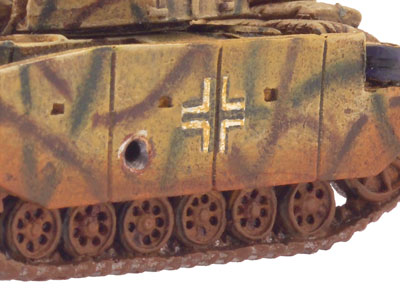 | Ostfront Panzer III by Warrick Main For modellers and painters of German Panzers, the Eastern Front (Ostfront) represents an excellent opportunity for individual creativity in the paint schemes. Most of the panzers in that theatre that had two or three colour paint schemes were painted by their crews. This led to the development of all kinds of strange and unusual blobs, spots and stripes being painted over the Dunkelgelb (dark yellow) basic paint. I wanted to show what one of these paint schemes may have looked like, had the tank crew had a short half-hour with the Battalion spray gun and two tins of paint. |
| For this article I am going to use a technique similar to that used to paint the Marder II’s in my previous article . The technique has been refined a little by practice and I wanted to get it out there to all my fellow FoW’ers. Be forewarned that this technique may take a little time to master; expect to spend a couple of hours getting it right, remember to be patient and careful, and you should end up with good results. I have discovered a new paintbrush nap (fibre) that has got me converted. It’s called ‘Indian Sable’. I hadn’t seen it ever before when I was shopping at the local art shop, and I liked the feel of it, so I bought one. It was love at first drybrush, I’m happy to say. It holds together well, flows paint very nicely, and washes clean easily too. If you want to try the techniques in this article, I recommend shouting yourself a #6 flat. I prefer not to use old brushes for drybrushing as they tend to have damaged bristles and leftover colours in the nap. A new brush has lots of bristles and can therefore hold a lot more paint and provide coverage for longer. This can be important if you don’t want to be refreshing the brush every thirty seconds. Also, a new brush will drybrush better and faster simply because the paint distribution effect happens more quickly and evenly. Every serious drybrusher should, at least once in their lives, buy a new brush solely for the purpose of drybrushing. Go ahead, you’re worth it. And if you’re not, Evan’s models certainly are! |
| Stage one of six In the first stage of painting, we need a good, solid basecoat. I choose to use Matisse Derivan ‘Structure’ in yellow oxide. This is a standard pigment in art and commerce, and was the basis of the dunkelgelb paint used on Germany’s panzers. It’s an easy way of making sure the base colour of your panzers is historically accurate. I water this down until it’s just a little thicker than normal acrylic model paint, and apply it liberally. You want to get paint into those cracks and crevices the first time, give it a little time to dry out, then touch up all the panels and raised surfaces that haven’t been properly covered by the first pass. | 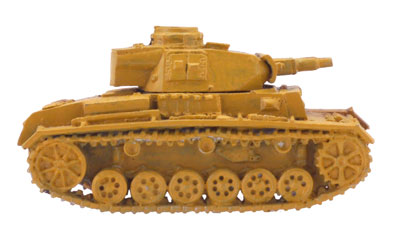 |
| The gaming miniatures that I paint have always received two basecoats by brush. It provides a good, solid foundation that helps resist handling wear and the odd unintentional airdrop. Spray cans are good for the busy, but I’m not sure all the fuss is justified: I’ve used them and then I have to go and do a bunch of ‘filling in’ of the missed spots. Now I just cut out the middle step and go right for the brushes. Plus, a brush allows you to lay it on thick over the high-handling, low-detail surfaces like turrets and flanks, but to thin it out as needed for low-handling parts with high detail (like exposed crew or stowage). After this is done, you should have a solid one-colour basecoat with no streaks or translucent patches. This is important, as the basecoat will still be the predominant paint showing on the final piece. |
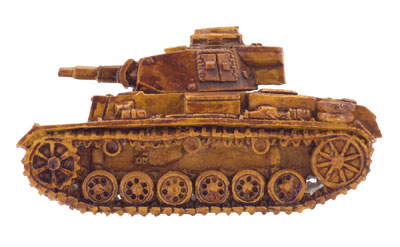 | Stage two of six In the next stage we use ink to develop shadows on our models. Just as some of the detail of the tanks is a little exaggerated, so as not to be lost, we need to exaggerate the shadows that they would cast. For this, ink is used in a generous wash. Ink is great because it doesn’t contain opaque pigments, and allows waterfast colours underneath it to ‘come through’ while minimising loss of detail. If your ink use obscures detail, you are applying it without enough dilution. The choice of inks is up to personal taste. I personally like to go for a much darker tone that the basic colour of the model, so for my yellow oxide basecoat I used GW brown ink. |
I tried chestnut ink and flesh wash also, but I thought that these didn’t work out as well as basic brown. You could go for the flesh wash if you wanted a ruddier, rusty tone, or you could ink with black. I don’t normally use this last as a shading ink as I reckon it dulls the colour of the model and doesn’t actually look better as shadowing, unless the model is a very dark grey. The mix in this case is about three-quarters ink to one-quarter water, and is mixed using a toothpick dipped in a little liquid dish soap. You may need more ink than you think. I use an eyedropper for ink measurement and I figure five drops of ink to two or three drops of water is about right for a panzer III; for a Tiger or Elefant you’ll need closer to seven or eight drops of ink to three or four drops of water. In any case, if you’re going to do it right, mix up enough for all the tanks you are doing in one go. |
| Stage three of six After a few hours’ drying time (reducible by gentle use of a hair dryer on a warm setting) your basecoated and inked tanks will be dry. Stage three is a drybrush, done to start the highlighting process. You want a shade that’s still slightly darker than the basecoat but lighter than the ink wash. In this case I have chosen to use GW Leprous Brown. Starting with a totally dry brush, dab up a little paint over the tip of the brush. Place the brush between a few folds of tissue or toilet paper and gently but firmly squeeze the paint out of the brush. | 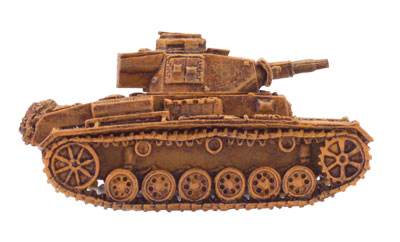 |
Once this is done, drag the nap of the brush along the paper a few times to separate out the bristles and ensure that there are no damp spots left in the nap. The brush is ready when it really looks dry and no colour comes off when you are doing the paper wiping. You want this drybrush to come out looking almost dusty, so you want the brush to be as dry as possible. Starting with an area of relatively high detail, brush the nap across the detail, concentrating on using the bottom half of the nap. You should start to see the detail developing matt highlights as you do this. Once a solid, basic highlight has appeared you can move on, refreshing the brush as required. Remember that the purpose of this stage is not to completely cover the inked basecoat, but to contrast with it and provide a basic guide as to where the detail will be when the highlighting is done. Make sure that the entire model is thoroughly highlighted, so that the raised areas can be seen distinctly. You also want to cover the inevitable blotches and rings that occur on large, flat surfaces, which have been inked. One last piece of advice, make sure that the amount of highlighting is even all over the tank. Too much highlighting in spots will cause your paintjob to look patchy and strange, and too little highlighting in spots will not show off the details. |
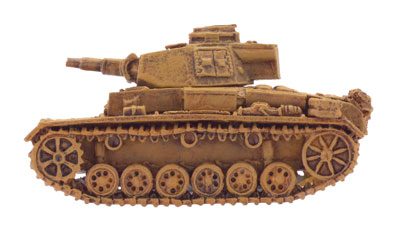 | Stages four of six Okay, so now your tanks are basecoated, inked and have a basic, natural-looking highlight. Now it’s time to develop the highlighting further, by doing a slightly brighter drybrush within the same shade. Before this, though, take a moment to have a look at the first drybrush coat you applied. It needs to look dusty. If it looks sticky instead of dry, you’ve used a brush that’s too wet. If you’ve lost flecks of detail of raised areas, either your basecoat was too thin and/or you were brushing too hard. |
With that out of the way, a second highlight is applied over the first in exactly the same way. For this stage I have chosen GW Vomit Brown as it is lighter in shade than the previous highlight coat, but still in that yellow/brown range I was looking for. This is applied to a lesser extent, concentrating a bit more on the detail and flat or raised areas. |
After this is complete you should be able to recognise distinct areas of detail when you hold the model at arms’ length (assuming your eyesight hasn’t been ruined by years hunched over a painting desk). Stages five of six | 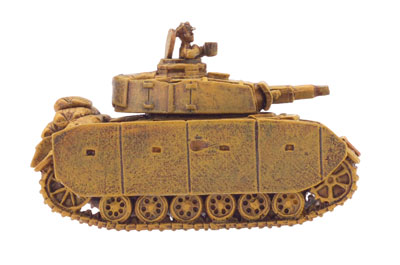 |
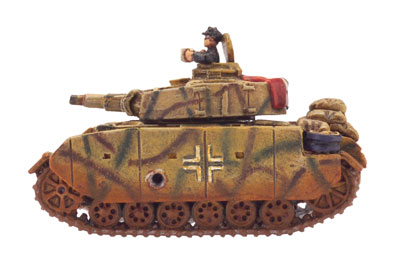 | Stage six, or the detailing strikes back By now you should have a model with good depth of highlighting and no ink blotches. All that remains is the detailing. The problem is that this stage will probably take as long as all that has gone before it… The first stage is a final, super-light drybrush on the most raised areas- the edges of armour plate, gun mantlets, schurzen, rivets and vision slits, for example. With this final drybrush these objects can really ‘pop’, visually speaking. My choice of colour for the final drybrush is GW Bleached Bone. |
The pale beige of this colour really helps the final level of fine detail without going too far outside the yellow/brown spectrum of the base colour. The next stage of detailing in this case was the camouflage stripes. A #1 or #2 round brush in hog bristle or Indian Sable will allow you, with care, to drybrush camo strips using a bit more paint than described above. By ‘a bit’ I actually mean to have the brush not totally dry, but just so damp that the bristles want to cling together. Take care to make sure that you keep the drybrushed line coherent by using just the tip of the brush. You may need to do the same strip several times. Just keep going until you get the desired result. Note that if you use a hog bristle brush (aka ‘bristle’) your nap will stick together better, as the nap is stiff and coarse. |  |
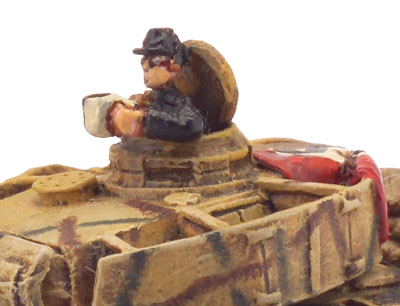 | This means that the lines you brush will be clearer and cleaner, but the effect won’t be as subtle. An Indian sable, on the other hand, will require more skill to keep from becoming blurred, as the nap is finer and softer. The final effect will be far better, though, as the nap will lay the paint more evenly. The two colours I used were Tamiya J.N. Green (XF-11) and GW Scorched Brown. A little soft lead pencil was used to sketch out the lines I intended to use. The drybrushing was applied carefully- the example above has about twenty-five minutes of work for half the tank. A whole tank would take me about thirty to forty minutes. |
Using my soft lead pencil again, the rough outline was sketched in and painted with good old black and white. This requires a steady hand but decals could be used as well. The mud is GW Bestial Brown and has been concentrated on the areas of highest exposure, the tracks and the bottom of the schurzen. After this, the final details include the flag and the Commander. The sandbags did not need any extra work as they were done during stages 1-5. The Commander looks to be savouring his morning cup of ersatz-kaffee, let’s hope that the Red Horde doesn’t spoil it for him! | 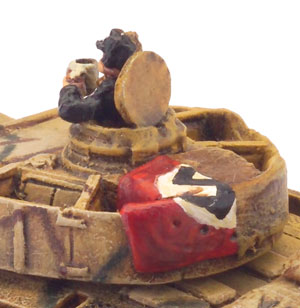 |
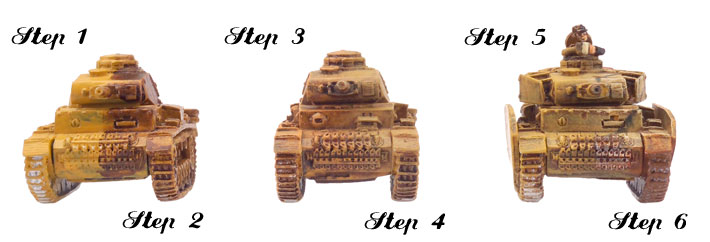 |

Ingen kommentarer:
Legg inn en kommentar